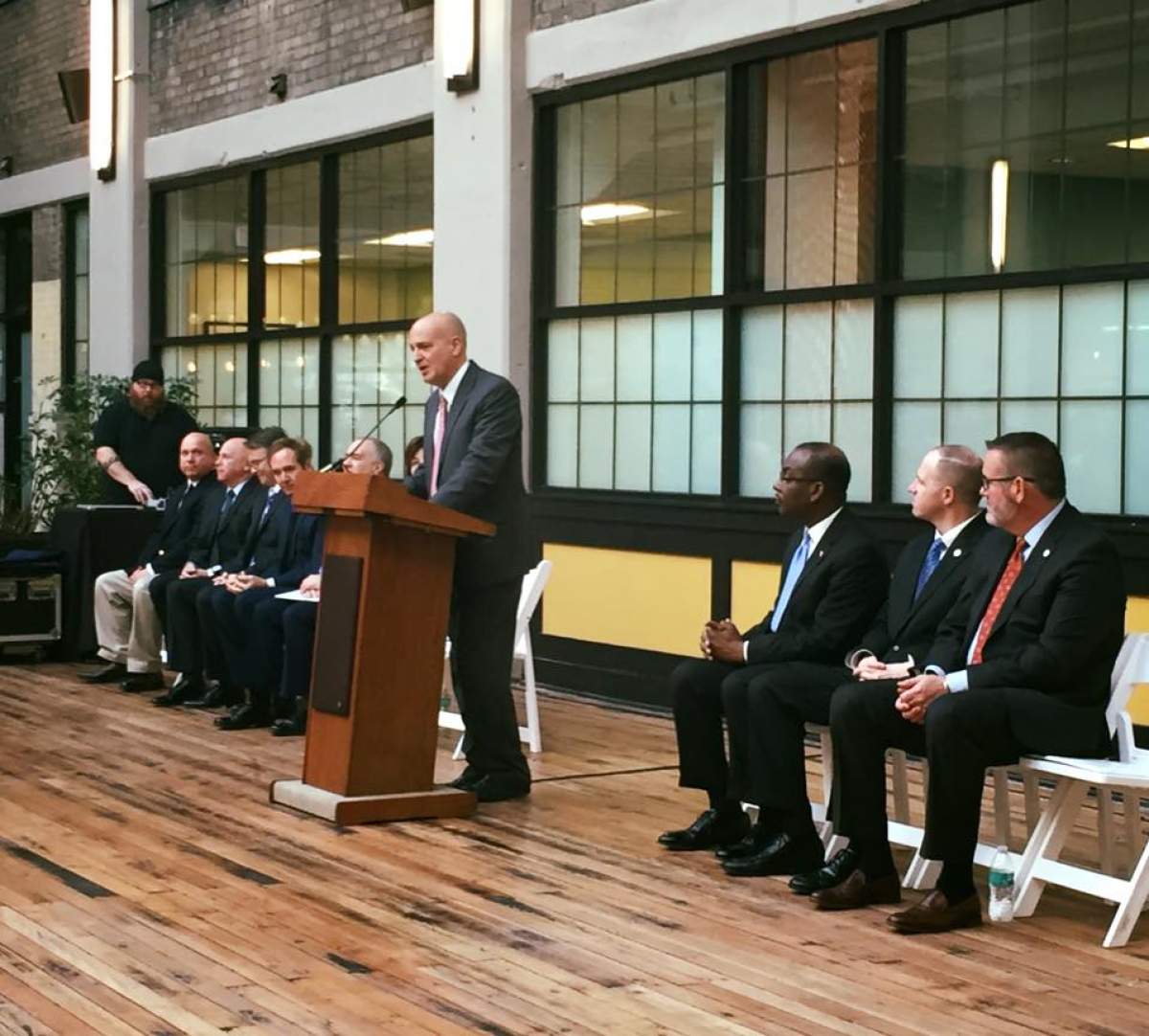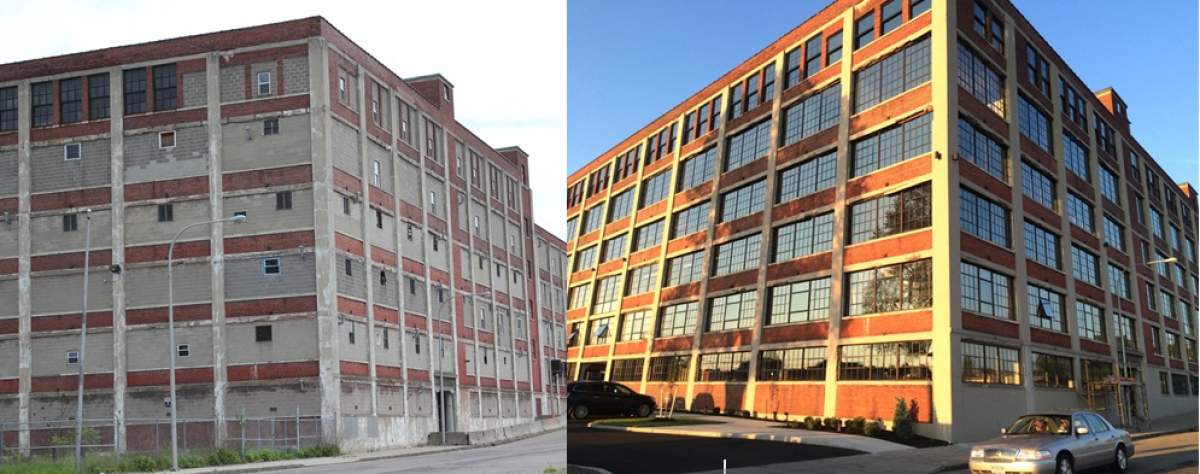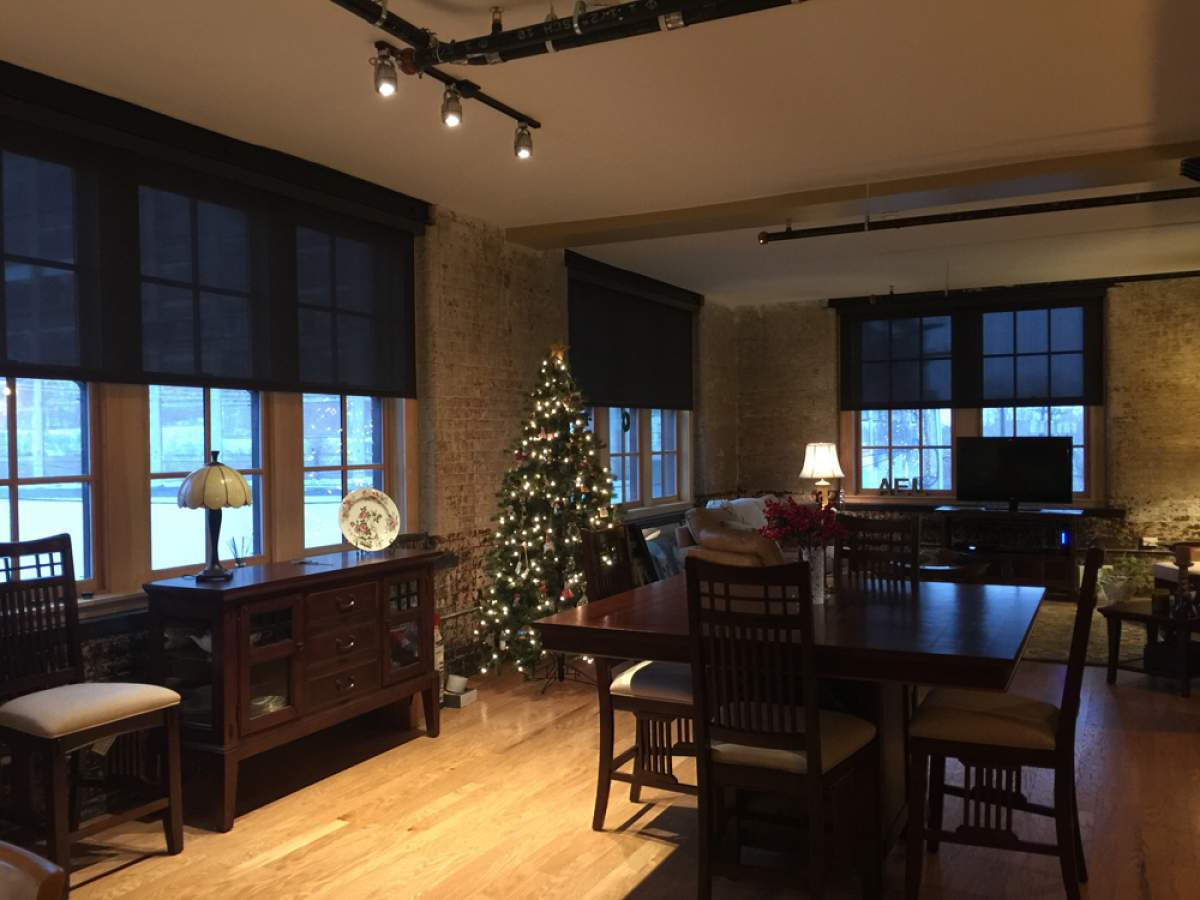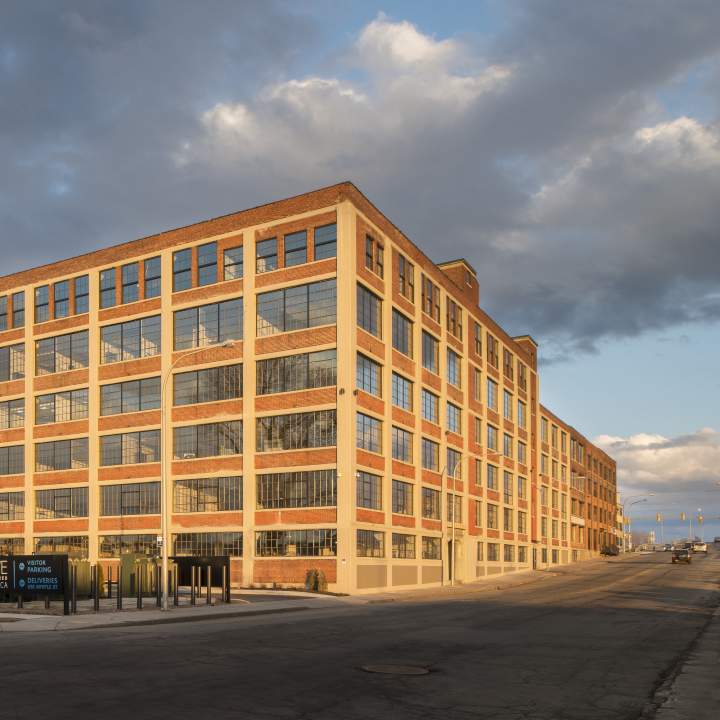February 18, 2016
Ribbon Officially Cut at 500 Seneca
Owner/partners Frontier Development Initiatives and Savarino Companies as well as President and CEO of the Community Preservation Corporation (CPC), Rafael E. Cestero, Lieutenant Governor Kathy Hochul, New York State Comptroller Thomas DiNapoli, U.S. Congressman Brian Higgins, Mayor Byron Brown, and New York State Senator Timothy M. Kennedy (D-63) joined development partners, tenants and community members to celebrate the completion of 500 Seneca Street.
Formerly a vacant manufacturing facility and brownfield site, the now renovated building provides 98 new apartments, commercial space, complimentary retail space and new economic opportunities that will act as a catalyst in the revitalization of the growing Hydraulics District.
“Through their hard work and vision, Frontier Development Initiatives and the Savarino Companies have returned 500 Seneca to its former glory, creating a resource that will serve both the economic and housing needs of this community for generations,” said the Community Preservation Corporation’s President and CEO, Rafael E. Cestero. “At CPC we’re proud to join our partners like Comptroller DiNapoli, SONYMA, and Citi who help make it possible for us to invest in transformative projects that create opportunities for neighborhoods to grow and thrive. I also want to recognize the Governor whose bold economic development efforts are making a real difference in the revitalization of cities like Buffalo, and many others throughout upstate New York.”
The building was originally constructed in 1901 as the headquarters of the F.N. Burt Company. F.N. Burt had a proud history in Buffalo, growing to become the largest paper box manufacturer in the world and employing over 1,500 people. The company was notable for being operated by Mary Cass. In an era when women could not even vote she rose through the ranks from floor worker to CEO. She was one of the founding members of Zonta International, an organization for professional women that began in Buffalo and now has chapters throughout the world. 500 Seneca is listed on the National Register of Historic Places as a classic example of a “modern” factory, built for efficiency, but also specifically to introduce natural light throughout the interior.
The large scale of the project and its designation as both a brownfield and an historic landmark required adherence to mandated guidelines and called for a development team with the financial strength, experience and capacity to bring it to successful completion. It also required a community-focused lender like CPC who understood the history of the building and the district, and the importance of investing in its growth. Today, the former 325,000 square foot plant has been transformed into a mixed-use property featuring 98 apartments affordable to the local workforce, as well as 130,000 square feet of new office and retail space that will serve as an asset to the community for generations to come.
Through a unique Pilot Increment Financing vehicle, sponsored by the City of Buffalo and the Erie County Industrial Development Agency, the property taxes generated by the project will be utilized to fund infrastructure improvements along the Seneca Street corridor including the immediate neighborhood surrounding the project. The $2.3 million in improvements will create a bike/pedestrian friendly green “complete street” link between downtown Buffalo and the developing Larkinville neighborhood to the east of 500 Seneca.
“Citi has a long relationship with CPC, investing in projects such as 500 Seneca that serve as catalysts for community revitalization. Buffalo’s beautiful architecture is representative of its rich history and this project preserves that, while stimulating additional economic development. For all these reasons, Citi is proud to be playing a part in this initiative,” said Matt Bissonette, Northeast Regional Director representing Citi Community Capital.
Owner/partners Frontier Development Initiatives and Savarino Companies as well as President and CEO of the Community Preservation Corporation (CPC), Rafael E. Cestero, Lieutenant Governor Kathy Hochul, New York State Comptroller Thomas DiNapoli, U.S. Congressman Brian Higgins, Mayor Byron Brown, and New York State Senator Timothy M. Kennedy (D-63) joined development partners, tenants and community members to celebrate the completion of 500 Seneca Street. Formerly a vacant manufacturing facility and brownfield site, the now renovated building provides 98 new apartments, commercial space, complimentary retail space and new economic opportunities that will act as a catalyst in the revitalization of the growing Hydraulics District.
“Through their hard work and vision, Frontier Development Initiatives and the Savarino Companies have returned 500 Seneca to its former glory, creating a resource that will serve both the economic and housing needs of this community for generations,” said the Community Preservation Corporation’s President and CEO, Rafael E. Cestero. “At CPC we’re proud to join our partners like Comptroller DiNapoli, SONYMA, and Citi who help make it possible for us to invest in transformative projects that create opportunities for neighborhoods to grow and thrive. I also want to recognize the Governor whose bold economic development efforts are making a real difference in the revitalization of cities like Buffalo, and many others throughout upstate New York.”
The building was originally constructed in 1901 as the headquarters of the F.N. Burt Company. F.N. Burt had a proud history in Buffalo, growing to become the largest paper box manufacturer in the world and employing over 1,500 people. The company was notable for being operated by Mary Cass. In an era when women could not even vote she rose through the ranks from floor worker to CEO. She was one of the founding members of Zonta International, an organization for professional women that began in Buffalo and now has chapters throughout the world. 500 Seneca is listed on the National Register of Historic Places as a classic example of a “modern” factory, built for efficiency, but also specifically to introduce natural light throughout the interior.
The large scale of the project and its designation as both a brownfield and an historic landmark required adherence to mandated guidelines and called for a development team with the financial strength, experience and capacity to bring it to successful completion. It also required a community-focused lender like CPC who understood the history of the building and the district, and the importance of investing in its growth. Today, the former 325,000 square foot plant has been transformed into a mixed-use property featuring 98 apartments affordable to the local workforce, as well as 130,000 square feet of new office and retail space that will serve as an asset to the community for generations to come.
Through a unique Pilot Increment Financing vehicle, sponsored by the City of Buffalo and the Erie County Industrial Development Agency, the property taxes generated by the project will be utilized to fund infrastructure improvements along the Seneca Street corridor including the immediate neighborhood surrounding the project. The $2.3 million in improvements will create a bike/pedestrian friendly green “complete street” link between downtown Buffalo and the developing Larkinville neighborhood to the east of 500 Seneca.
“Citi has a long relationship with CPC, investing in projects such as 500 Seneca that serve as catalysts for community revitalization. Buffalo’s beautiful architecture is representative of its rich history and this project preserves that, while stimulating additional economic development. For all these reasons, Citi is proud to be playing a part in this initiative,” said Matt Bissonette, Northeast Regional Director representing Citi Community Capital.
“The combination of affordable housing, office space and redevelopment of former manufacturing space is going to be a key driver to redevelop the Hydraulics District and bring economic vitality to this important neighborhood in Buffalo. We’re proud to be part of this exciting new development,” said Jennifer Westerbeck, vice president of U.S. Bancorp Community Development Corporation.
To create a sustainable, environmentally friendly project and respect the site’s historic significance, the developers restored the building’s essential design and structural elements. The historic windows were either painstakingly restored or replaced in kind. Many of the commercial offices feature furniture constructed of wood, iron and other materials salvaged from the building; large reproductions of original photographs of the building and its occupants adorn the corridor walls.
Modern enhancements include an interior atrium with operable sky-lights, enclosed outdoor courtyard and a state-of-the-art energy efficient climate control system.
Community-centered amenities at 500 Seneca Street include a communal outdoor deck area, a tenant activity center, a two-level, fully equipped fitness center, an art gallery, meeting and training space, a breakfast and lunch café, a first-floor therapy and wellness center, a bicycle storage and repair facility, climate-controlled indoor storage and canine day care. Coming soon are a curated wine cellar and a full service restaurant featuring a wood fired oven and outdoor dining patio. Some of the commercial space is being utilized by community organizations at below market rent.
The 98 residential apartments offer a choice of 32 unique and different apartment unit layouts ranging in size from 600 square foot studio units to 1,900 square foot three bedroom units. Apartment finishes include exposed brick walls and wood plank flooring – a nod to the building’s past. The residential portion of the project recently came on line and is already 75 percent leased.
The commercial space at 500 Seneca Street spans all six floors of the building. Features of the office environments include energy efficient and comfortable climate control systems, interior green atrium with coffee bar and food service and adjacent secure parking. The commercial space is currently 80% leased with tenants including KPMG, Oracle, Liberty Mutual, ABC Amega, Nervve Technologies, BeneCare, Elderwood Affiliates, Provident Funding, Hoffman-Hanafin, Bradford Energy Capital, Tommyrotters Distillery, Impulse Guide, Leadership Buffalo, OCG Interiors and BCOME Buffalo. Partners Frontier Development Initiatives and Savarino Companies also have offices in the building. Tenants such as Animal Outfitters, W&S Wine Purveyors, Phoenix Rising Spa, The Lunch Box Café, Casa Soldano Restaurant, B. Layne Creations, Hydraulics Fitness Center and CEPA Gallery provide complimentary services for residents, tenants and neighbors.
To finance the transformation of 500 Seneca Street, CPC, along with lender partner Citi, provided a $24 million construction loan. CPC also provided a SONYMA-insured $18.68 million permanent loan through the New York State Common Retirement Fund (CRF) which is administered by the office of the New York State Comptroller. US Bank invested $12 million in the project’s federal and New York State Historic Tax Credits.
The firm of Chaintreuil Jensen Stark served as Project Architect. EBS Engineers, Tredo Engineers, Benchmark Environmental Consultants and Watts Engineering all provided consulting and/or engineering services on the project. Savarino Construction served as General Contractor. The facility is managed by Savarino Properties.
Cannon Heyman Weiss served as Historic Tax Credit Counsel. The Slater Law Firm served as environmental counsel. Plante-Moran of Detroit, Michigan provided the third party financial and accounting services required by the Historic Tax Credit transaction.
The original article can be found at Buffalo Rising by clicking here.





